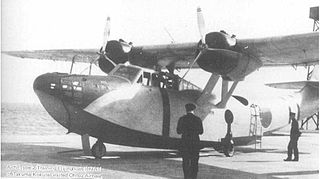Related Research Articles

The Aichi D1A or Navy Type 94/96 Carrier Bomber was a Japanese carrier-based dive bomber of the 1930s. A single-engine, two-seat biplane based on the Heinkel He 50, the D1A was produced by Aichi for the Imperial Japanese Navy, remaining in service as a trainer at the time of the attack on Pearl Harbor. The D1A was produced in two variants, the D1A1, and the D1A2.

The Mitsubishi B5M was an Imperial Japanese Navy Air Service (IJNAS) land-based attack aircraft, originally intended for aircraft carrier use. The B5M was also given the long formal designation Navy Type 97 Mk.2 Carrier Attack Bomber and Allied reporting name of Mabel. This aircraft was mistakenly known as the Nakajima Army 97 by the British.

The Aichi H9A was an Imperial Japanese Navy Air Service flying boat used during the first years of World War II for crew training. An uncommon type, it was not encountered by Allied forces until Spring 1945 and was never assigned an Allied reporting name.

The Nakajima A1N, or Navy Type 3 Carrier Fighter, was a Japanese carrier-based fighter of the late-1920s and early-1930s. It was a licensed copy of the British Gloster Gambet fighter, built by the Nakajima Aircraft Company for the Imperial Japanese Navy. Approximately 150 were built in two versions, the A1N1 and A1N2.

The Yokosuka B4Y was a carrier-borne torpedo bomber used by the Imperial Japanese Navy Air Service from 1936 to 1943. The B4Y replaced the Mitsubishi B2M2 and the Yokosuka B3Y, and was the last biplane bomber used operationally by the Imperial Japanese Navy. The Allied reporting name was "Jean". This aircraft was mistakenly identified by the British as the Nakajima Navy G-96.

The Nakajima E4N was a Japanese shipboard reconnaissance aircraft of the 1930s. It was a two-seat, single-engine, equal-span biplane seaplane used primarily by the Imperial Japanese Navy.

The Nakajima E8N was a Japanese ship-borne, catapult-launched, reconnaissance seaplane of the Second Sino-Japanese War. It was a single-engine, two-seat biplane with a central main-float and underwing outriggers. During the Pacific War, it was known to the Allies by the reporting name "Dave". This aircraft was identified by the British as the Nakajima KT-95 Dave.

The Nakajima Ki-34 was a Japanese light transport of World War II. It was a twin-engine, low-wing monoplane; the undercarriage was of tailwheel type with retractable main units. During the Pacific War, the Allies assigned the type the reporting name Thora.

The Nakajima Type 91 fighter was a Japanese fighter aircraft of the 1930s. It was a single-engine, single-seat parasol monoplane with a fixed, tailskid undercarriage.

The Aichi E16A Zuiun was a two-seat reconnaissance seaplane operated by the Imperial Japanese Navy during World War II.

The Mitsubishi Ki-18 was an unsuccessful and unsolicited attempt by Mitsubishi to meet a 1934 requirement issued by the Japanese Army for a modern single-seat monoplane fighter suitable to the needs of the Imperial Japanese Army Air Force. During this competition, Nakajima entered the Nakajima Ki-11, and Kawasaki entered the more maneuverable Kawasaki Ki-10 biplane. The competition was won by Kawasaki, but the new fighter was not accepted by the IJAAF with much enthusiasm.

The Aichi E3A was a reconnaissance seaplane developed in Germany as the Heinkel HD 56 to operate from warships of the Imperial Japanese Navy, which designated it the Type 90-1 Reconnaissance Seaplane. It was a conventional single-bay biplane with staggered wings braced by N-type interplane struts. The pilot and gunner sat in tandem, open cockpits.
The Nakajima B3N was a prototype Japanese carrier-based torpedo-bomber aircraft of the 1930s. A single-engined biplane with a crew of three, it was unsuccessful, only two being built.
The Nakajima P-1 was a 1930s Japanese single engine, single seat biplane intended for night mail flights, derived from the Nakajima E4N3 Naval reconnaissance seaplane. Nine were built.
The Kawanishi E10K, also known as Kawanishi Type T, Kawanishi Navy Type 94 Transport Seaplane and Kawanishi Navy Experimental 9-Shi Night Reconnaissance Seaplane, was a small Japanese flying boat of the 1930s. It was a single-engined biplane intended to meet a requirement for a night reconnaissance aircraft for the Imperial Japanese Navy but was not selected for production, the single prototype being converted to a transport and operated as the Navy Type 94 Transport.
The Mitsubishi Ka-8 or Mitsubishi Experimental 8-Shi Two-seat Fighter was a prototype Japanese two-seat carrier-based fighter aircraft of the 1930s. Two were built, but no production followed.
The Kawanishi K8K was a Japanese floatplane trainer designed and built by the Kawanishi Aircraft Company for the Imperial Japanese Navy. It was selected for production, but only a small number were built before a change in the Japanese Navy's training needs led to production being stopped.
The Kawanishi E13K, company designation AM-19, was a Japanese 1930s three-seat reconnaissance floatplane.
The Kawanishi K6K was a prototype Japanese training aircraft built by the Kawanishi Aircraft Company in the late 1930s.
The Watanabe K8W was a Japanese floatplane trainer designed and built by Watanabe for the Imperial Japanese Navy.
References
- ↑ "Nihon L7P". aviadejavu.ru. Retrieved 27 January 2019.
- ↑ Mikesh, Robert; Shorzoe, Abe (1990). Japanese Aircraft 1910–1941. London: Putnam. pp. 240–241. ISBN 0-85177-840-2.